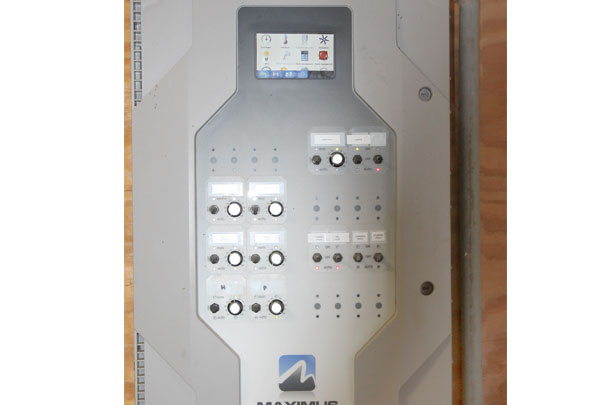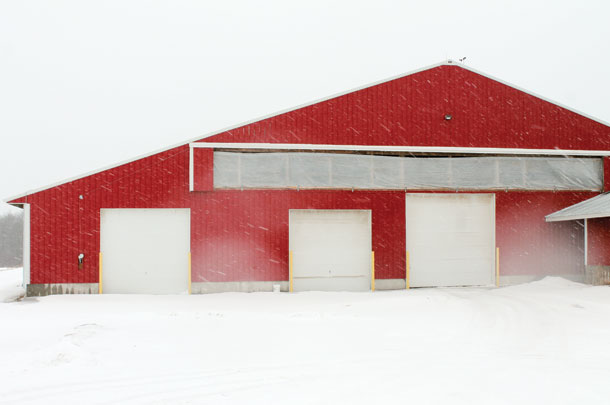Thanks to touchless ventilation and lighting technology borrowed from the swine and poultry industries, maintaining a consistent barn environment on one New York dairy is a breeze.
When adding cow housing in 2014, Mapleview Dairy LLC chose to install a Maximus system to control all the environmental aspects of the facility. Everything, including fans, lights, soakers and curtains, is fully automated and can be monitored by phone, tablet or any Internet connection.

Variables are monitored by using wind, temperature and humidity sensors mounted in the barn.
“The reason we put this system in is to provide the best cow comfort and environmental consistency in all seasons, warm or cold,” Jordan Fisher, parlor and youngstock manager at Mapleview Dairy, says. The new freestall barn outfitted with the no-touch system houses the farm’s high-group milkers.
Fisher farms in partnership with his brother, Jacob; father, David; and aunt and uncle, LouAnne and John King. The farm, consisting of 2,600 head of mostly Holstein cows with a 27,500-pound herd average and 4,500 acres of cropland, operates near the Canadian border. Average annual snowfall is 80 inches per year, and winter temperature lows average around 6ºF.
While it’s hard to quantify in exact terms the number of additional pounds of production per cow when measuring multiple variables like temperature and photo period, the dairy’s management feels that investments in cow comfort pay off in the long run, even if a specific number can’t be attributed to the return.
“Any time you can have more comfortable cows, it’s going to pay more quickly,” Fisher says.
Fisher sees how the cows benefit from an environment that is controlled and consistent.
“Automation is more consistent than human handling,” he adds. “It takes out the possibility of human error. Someone goes in the barn and thinks it’s too cold and closes the curtains, but the reality is: Maybe the temperature is just right for the cows.”

Wind sensors help by monitoring crosswinds and keep bedding dry during storms. “I think that’s a big deal,” he adds.
Lights are set to provide 16 hours of light daily, switching on at 5 a.m. and shutting off automatically at 9 p.m.
When it comes to controlling the environment of the tunnel-ventilated barn, each level of automated control is staged to begin at a temperature programmed in by the farm. First, the circulating fans begin, followed by curtains opening and tunnel fans initiating. Lastly, the soakers turn on if the temperature requires.
“On a hot summer day last year, I came into the new barn, and the thermometer was 8 degrees cooler than in the barn where we don’t have the automated controls,” Fisher says. While the new barn features improved design for ventilation, he attributes at least some of the difference to the no-touch environmental control system.
Justin Shantel of ASAP Interiors installed the control system.
“Everyone thinks the temperature is too high or too low and adjusts ventilation; that is where you get a lot of respiratory problems,” Shantel says.
Because the system is controlled via the Internet or wireless communication, most system service can be performed remotely, saving on a service call. The controls also monitor if a change occurs, such as fans starting or stopping outside of designated parameters.
The controls determine if the change occurred on the farm or through an electronic device, eliminating finger-pointing as to who made the change and when.
Cost of installation depends upon how many variables are wrapped into the main controller. It is an expensive way to control only one modifier such as the soakers; however, the more controls stacked into the system, the more accurate and economical the entire ventilation system becomes.
Shantel notes that energy savings are incurred because fans and other controls are not switching on and off as frequently. Many energy providers also offer rebates for installing energy-saving devices.
Startup and shutdown of each system component is programed to begin when designated temperature, humidity or wind level is attained. When shutting down, the components operate beyond the designated control stop so that the components shut down gradually and not all at once, a feature that holds a barn to correct conditions for longer periods of time.
The system is manufactured in Montreal and was initially produced for the swine and poultry industries. It is new enough to the dairy sector that hard numbers on actual energy efficiencies gained through its use are not available.
As with any new tool, there are always hiccups.
“Initially, we didn’t have a couple of settings working quite right,” Fisher says. “A wind sensor wasn’t communicating, and we missed a curtain close and ended up with a lot of wet bedding. But once we were entirely set up, it was simple, and things seem to be working.”
Fisher believes the control system is a useful tool for any-scale dairy, as multiple barns can be tied into the main control through Internet service.
Mapleview Dairy has a goal of connecting all future building projects into the controller and managing all housing environments through the system. PD
Bev Berens is a freelance writer in Holland, Michigan.
PHOTO 1: The high-producing group enjoys 16 hours of long-day lighting. The automated system turns lights on at 5 a.m. and off at 9 p.m.
PHOTO 2: At Mapleview Dairy, everything, including fans, lights, soakers and curtains, are fully automated and can be monitored by phone, tablet or any Internet connection. Variables are monitored by using wind, temperature and humidity sensors mounted in the barn.
PHOTO 3: The automated system engages pre-set stages of cooling in order to maintain a consistent, comfortable temperature year-round in the tunnel-ventilated barn, including fans and curtains. Photos courtesy by LouAnne King and Mapleview Dairy.





